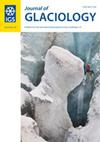静止期间的传播加速升级为 2020-2021 年阿拉斯加东南部 Sít' Kusá 的激增
IF 2.6
3区 地球科学
Q2 GEOGRAPHY, PHYSICAL
引用次数: 0
摘要
我们利用卫星图像处理技术测量了温带涌浪冰川 Sít' Kusá 在整个 2013-2021 年涌浪周期中的表面高程和速度变化。我们详细记录了冰川在静止期(2013-2019 年)和激增期(2020-2021 年)的动态变化。在整个静止期间,我们观察到数量级的冰川加速,这些加速从冰川北部支流上游的陡峭冰瀑上方季节性地向下传播,进入冰川激增部分的蓄水区。加速从秋季开始,在整个冬季逐渐加快,直到春末融化开始后约 1-2 个月达到峰值。加速度的传播距离控制着冰川涌动前库区的质量累积分布。此外,每年加速的强度和传播距离与前一个融化季节的正度日总和相关,这表明冬季融水储存驱动了季节性加速。我们证明,加速在运动学上与 2020-2021 年的激增相似,不同之处主要在于激增传播过了库区下限的动态平衡线,这可能是由于库区的质量累积和基底焓超过了临界点而引发的。本文章由计算机程序翻译,如有差异,请以英文原文为准。
Propagating speedups during quiescence escalate to the 2020–2021 surge of Sít’ Kusá, southeast Alaska
We use satellite image processing techniques to measure surface elevation and velocity changes on a temperate surging glacier, Sít’ Kusá, throughout its entire 2013–2021 surge cycle. We present detailed records of its dynamic changes during quiescence (2013–2019) and its surge progression (2020–2021). Throughout quiescence, we observe order-of-magnitude speedups that propagate down-glacier seasonally from the glacier's upper northern tributary, above a steep icefall, into the reservoir zone for the surging portion of the glacier. The speedups initiate in fall and gradually accelerate through winter until they peak in late spring, ~1 − 2 months after the onset of melt. Propagation distance of the speedups controls the distribution of mass accumulation in the reservoir zone prior to the surge. Furthermore, the intensity and propagation distance of each year's speedup is correlated with the positive degree day sum from the preceding melt season, suggesting that winter melt storage drives the seasonal speedups. We demonstrate that the speedups are kinematically similar to the 2020–2021 surge, differing mainly in that the surge propagates past the dynamic balance line at the lower limit of the reservoir zone, likely triggered by the exceedance of a tipping point in mass accumulation and basal enthalpy in the reservoir zone.
求助全文
通过发布文献求助,成功后即可免费获取论文全文。
去求助
来源期刊

Journal of Glaciology
地学-地球科学综合
CiteScore
5.80
自引率
14.70%
发文量
101
审稿时长
6 months
期刊介绍:
Journal of Glaciology publishes original scientific articles and letters in any aspect of glaciology- the study of ice. Studies of natural, artificial, and extraterrestrial ice and snow, as well as interactions between ice, snow and the atmospheric, oceanic and subglacial environment are all eligible. They may be based on field work, remote sensing, laboratory investigations, theoretical analysis or numerical modelling, or may report on newly developed glaciological instruments. Subjects covered recently in the Journal have included palaeoclimatology and the chemistry of the atmosphere as revealed in ice cores; theoretical and applied physics and chemistry of ice; the dynamics of glaciers and ice sheets, and changes in their extent and mass under climatic forcing; glacier energy balances at all scales; glacial landforms, and glaciers as geomorphic agents; snow science in all its aspects; ice as a host for surface and subglacial ecosystems; sea ice, icebergs and lake ice; and avalanche dynamics and other glacial hazards to human activity. Studies of permafrost and of ice in the Earth’s atmosphere are also within the domain of the Journal, as are interdisciplinary applications to engineering, biological, and social sciences, and studies in the history of glaciology.
 求助内容:
求助内容: 应助结果提醒方式:
应助结果提醒方式:


